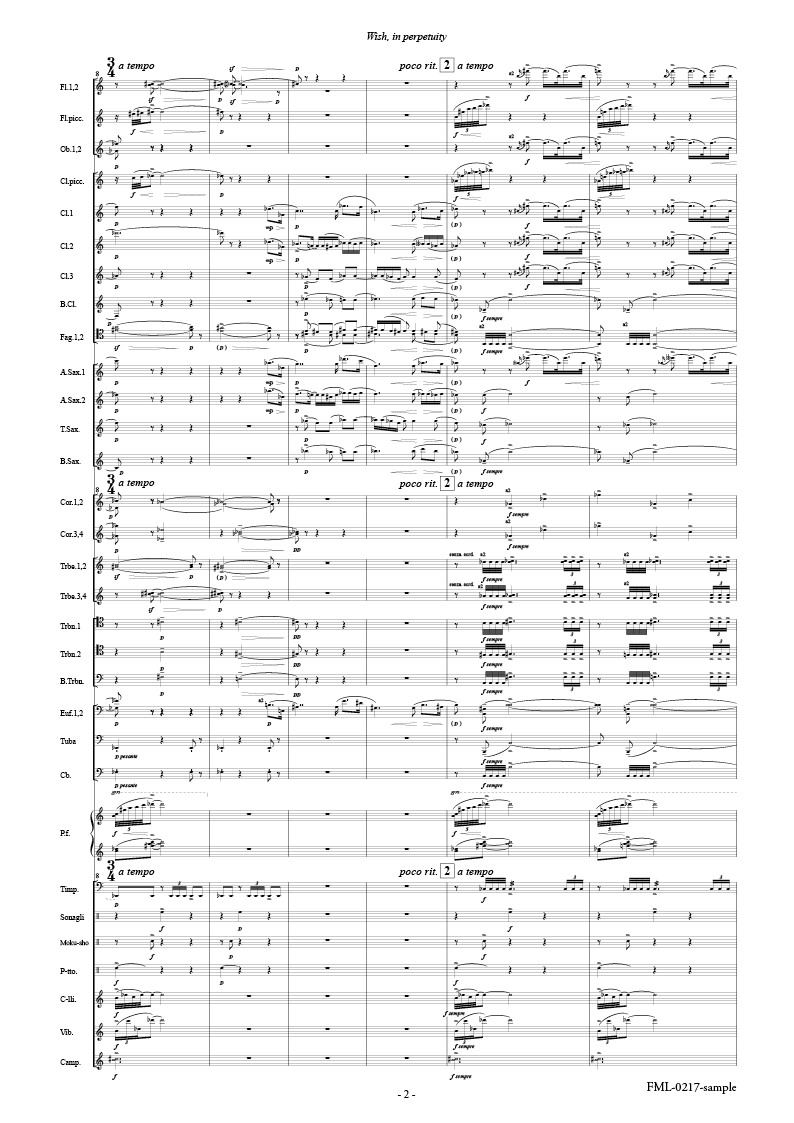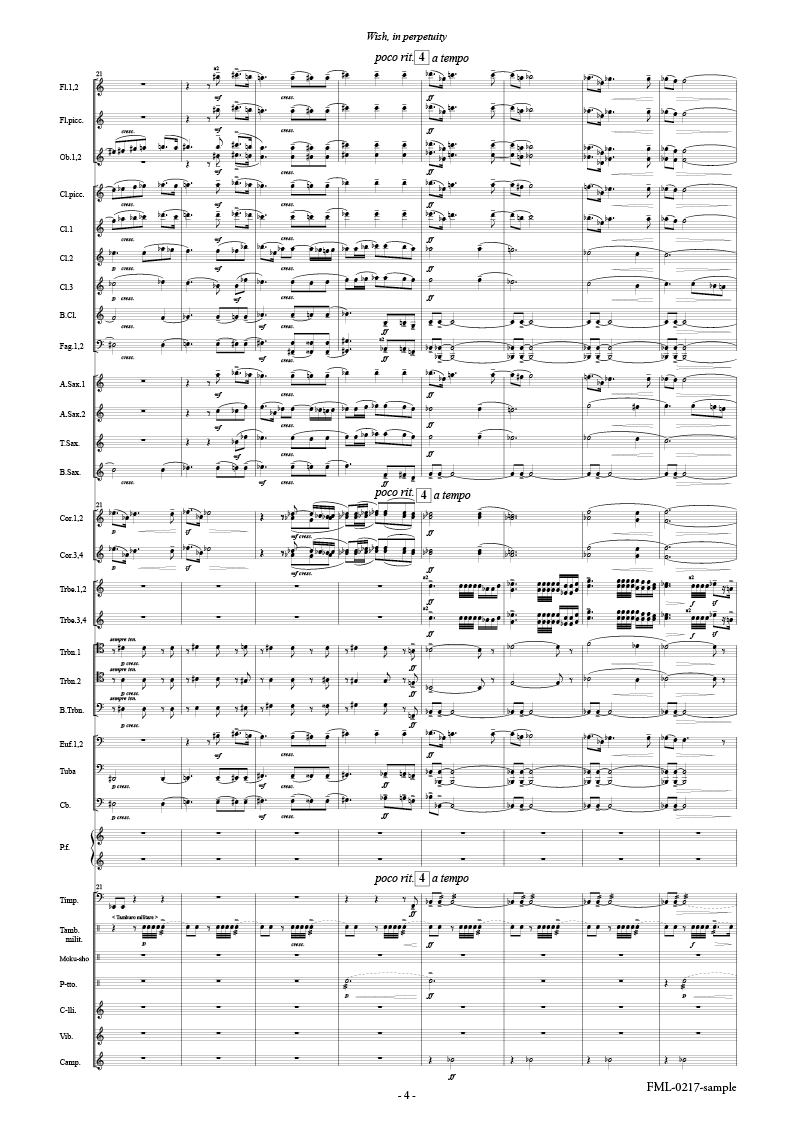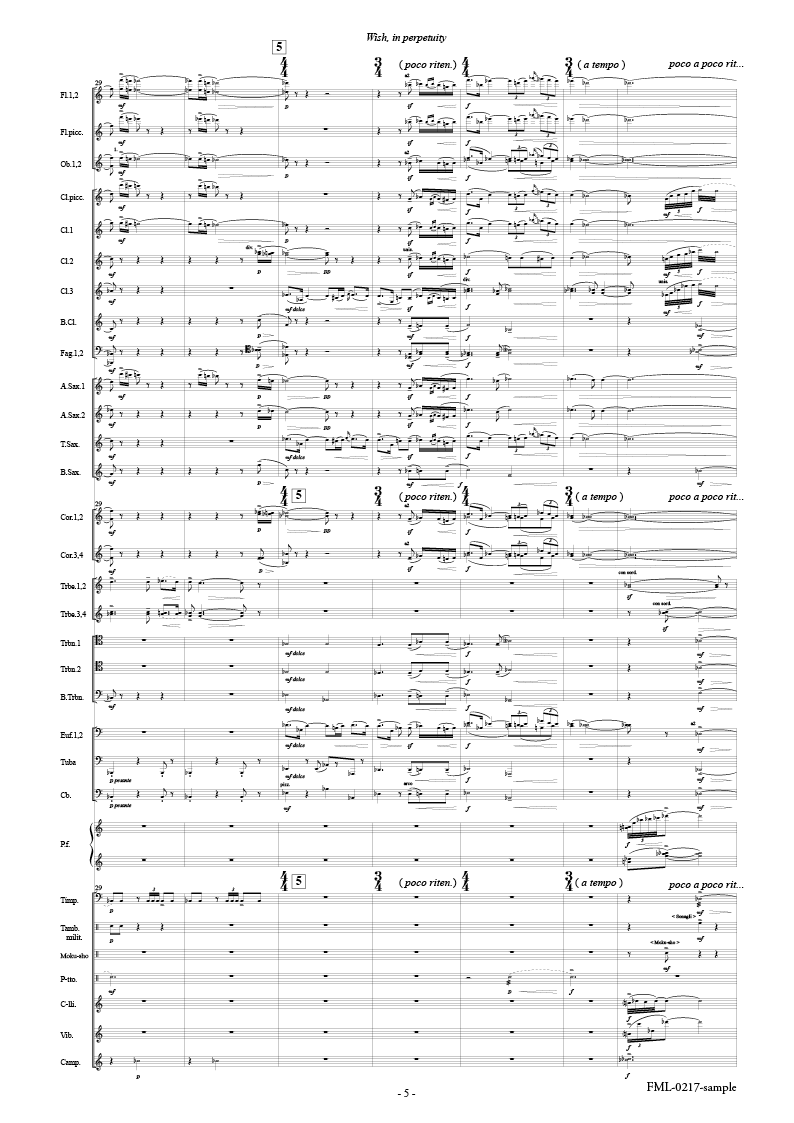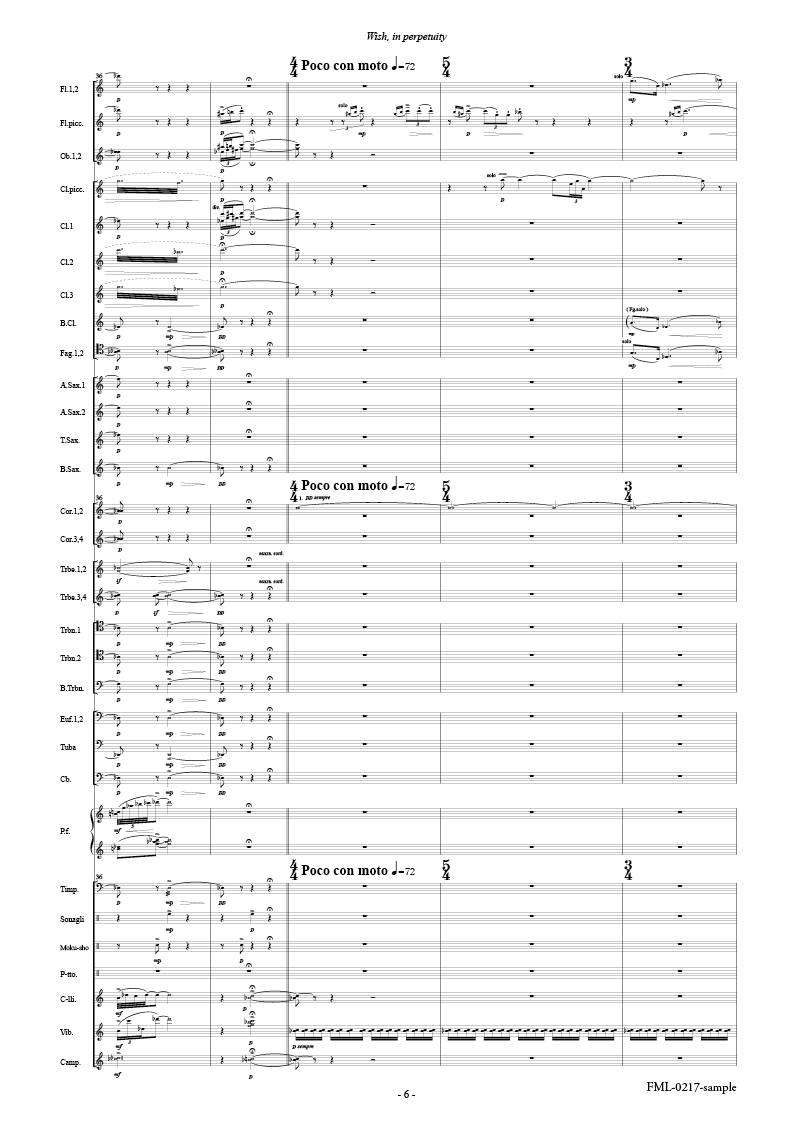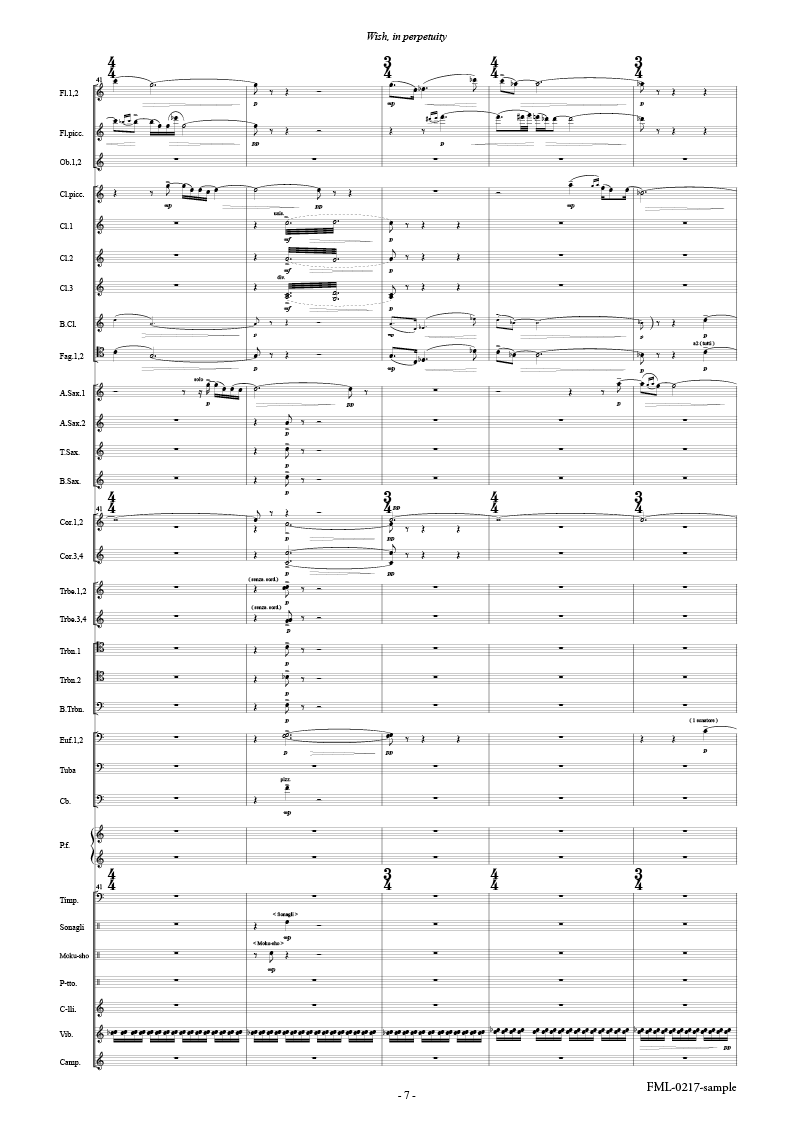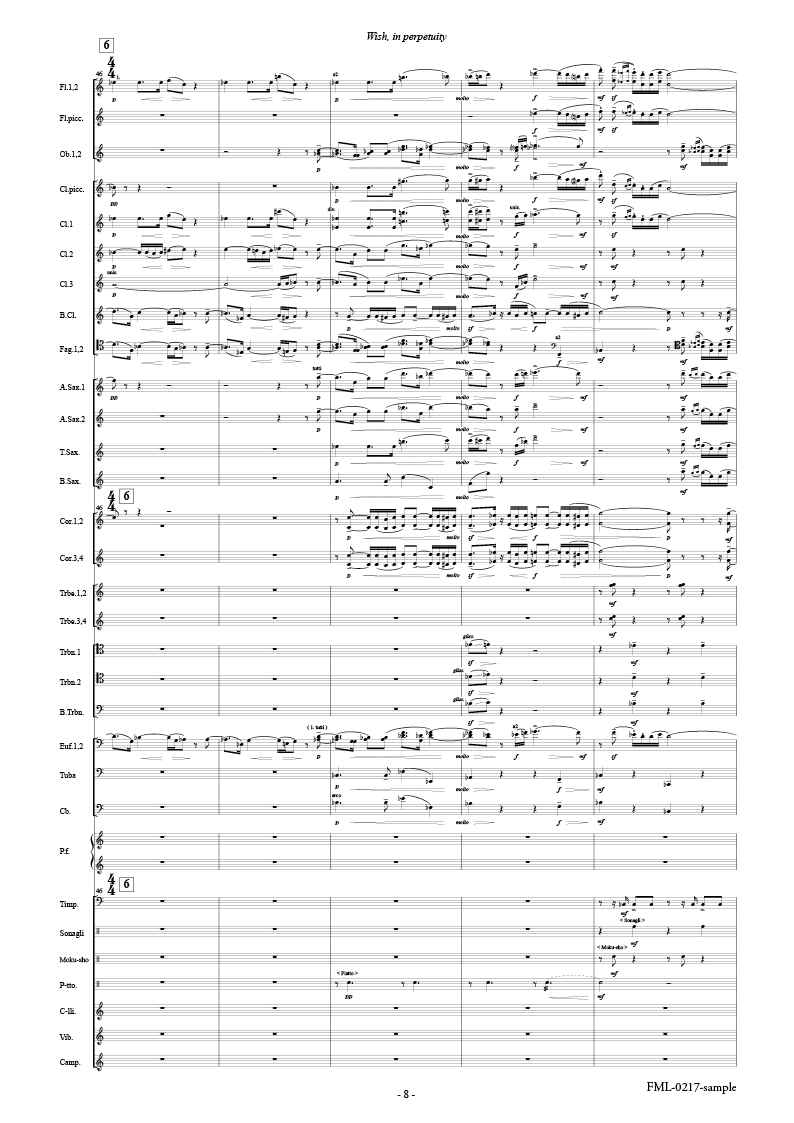12月25日15時を持ちまして、
2025年内出荷の注文受付を終了いたしました。
以降のご注文は年明け
【 2026年1月7日(水)以降順次出荷 】
となります。予めご了承ください。
本年もたくさんのご愛顧を賜りありがとうございました。
よいお年をお迎えください。
千代のかざし:井澗昌樹 [吹奏楽スコア]
・1配送につき税込11,000円以上のご注文で国内送料無料
・コンビニ後払い、クレジットカード、銀行振込利用可
・[在庫あり]は営業日正午までのご注文で即日出荷
・International Shipping
- 概要
- 編成/曲目
- 補足
- ENGLISH
千代のかざし
- 色々に さかへて匂へ 桜花 我君々の 千代のかざしに -
かざしとはかんざし(簪)、古くは髪や冠に木の葉や花を挿していたそうで、植物の生命力を自らに付着させるための呪術的行為だったそうです。日本最古の歴史書『古事記』には、倭建命が自身の死を悟った際、従者たちに向かって「無事に大和へ戻り生命を謳歌せよ」と歌う場面があります。「お前たちは故郷の大きな樫の葉を髪に挿せ!」とドラマティックな言葉で詠まれており、古代人の何と豊かな感性と浪漫性、思い返すたびに心が震えます。
本作品のタイトルは、南北朝時代の歴史書『増鏡』より引用したものです。「彩り美しく咲いて栄えた桜花」が飾り続けるものはもちろん帝の冠かなと思いますが、ずいぶんと時が流れまして「君」の言葉の意味も広くなりました。生きとし生けるもの全てを「君々」と致しまして、千代に…それは1000年、転じて永遠に華めく世界でありますよう、淡い祈りとして作曲した作品です。(井澗昌樹)
仕様
- アーティスト
- 作曲: 井澗昌樹
- 演奏形態
- 吹奏楽
- 編成
- 大編成 / 43パート
- 演奏時間
- 0:09:56
- グレード
- 4
- 商品カテゴリ
- スコア
- 出版社 / 品番
- フォスターミュージック / FML-0217FS
- JANコード
- 4560318475793
- 発売日(年)
- 2020/10/07
- 【レンタル譜】千代のかざし:井澗昌樹 [吹奏楽大編成]
スタディスコア/セット・版違いなど
楽器編成
- Piccolo
- Flute 1
- Flute 2
- Oboe 1
- Oboe 2
- Bassoon 1
- Bassoon 2
- Eb Clarinet
- Bb Clarinet 1 (div.)
- Bb Clarinet 2
- Bb Clarinet 3 (div.)
- Bass Clarinet
- Alto Saxophone 1
- Alto Saxophone 2
- Tenor Saxophone
- Baritone Saxophone
- Trumpet 1
- Trumpet 2
- Trumpet 3
- Trumpet 4
- Horn 1
- Horn 2
- Horn 3
- Horn 4
- Trombone 1
- Trombone 2
- Bass Trombone
- Euphonium 1
- Euphonium 2
- Tuba (div.)
- String Bass (div.)
- Piano
- Timpani
- Percussion 1 (Snare Drum, Sleigh bells)
- Percussion 2 (Moku-sho, Hi-hat, Cymbals)
- Percussion 3 (Suspended Cymbal)
- Percussion 4 (Glockenspiel)
- Percussion 5 (Vibraphone)
- Percussion 6 (Tubular Bells)
井澗昌樹(Masaki Itani)
大阪教育大学教養学科芸術専攻音楽コース卒業。同大学大学院芸術文化専攻修了。作曲を澤田博、北川文雄の両氏に師事。
主な作品に、バリトン独唱と管弦楽のためのカンタータ「倭建命 流離譚」、トランペット八重奏曲「四季の奏鳴」など。吹奏楽作品に、「火の断章」(2008年度全日本吹奏楽コンクール課題曲)、「Bye Bye Violet」、「愛の祭壇」など。
- サイズ
- A4/1cm未満
WISH, IN PERPETUITY:Composer: Masaki ITANI
In the olden days, ornate Japanese hairpins known as Kanzashi featuring leaves and flowers were often inserted into one's hair or headdress as a ritual for absorbing the life force of plants into their physical body. In Japan's oldest historical manuscript "Kojiki," there is a scene where Yamato Takeru realized that he was about to die and ordered his followers to return to Yamato safely and celebrate their life. He then articulated the dramatic words "Pin the giant oak leaves at your hometown into your hair!" I am always profoundly moved when I am reminded of the rich sensibilities and romantic impulses of ancient people.
The title of this piece was taken from "Masukagami," a historical tale from the period of the Northern and Southern Courts. Its composition was inspired by a faint hope that all living things can be part of a glorious world for the next 1000 years and the rest of eternity.
Specifications
- ARTIST
- Composer: Masaki ITANI
- INSTRUMENTATION
- Windband / More than 36 Players
- DURATION
- 0:09:56
- GRADE
- 4
- PRODUCT TYPE
- STUDY SCORE (PARTS Sold separately)
- PUBLISHER / Code
- fostermusic Inc. / FML-0217FS
- JAN
- 4560318475793
- RELEASE
- 2020/10/07
- OVERSEAS SHIPMENT
- Yes
- EUROPEAN PARTS
- Not Included
For foreign customers,
You can now purchase from overseas via WorldShopping BIZ.
Study scores, ensembles, and CDs can be ordered directly from our website.
Rental sheet music and some other items are not covered by this cart system, so please contact us by email.

![千代のかざし:井澗昌樹 [吹奏楽スコア]](/html/upload/save_image/FML0217_3.png)
